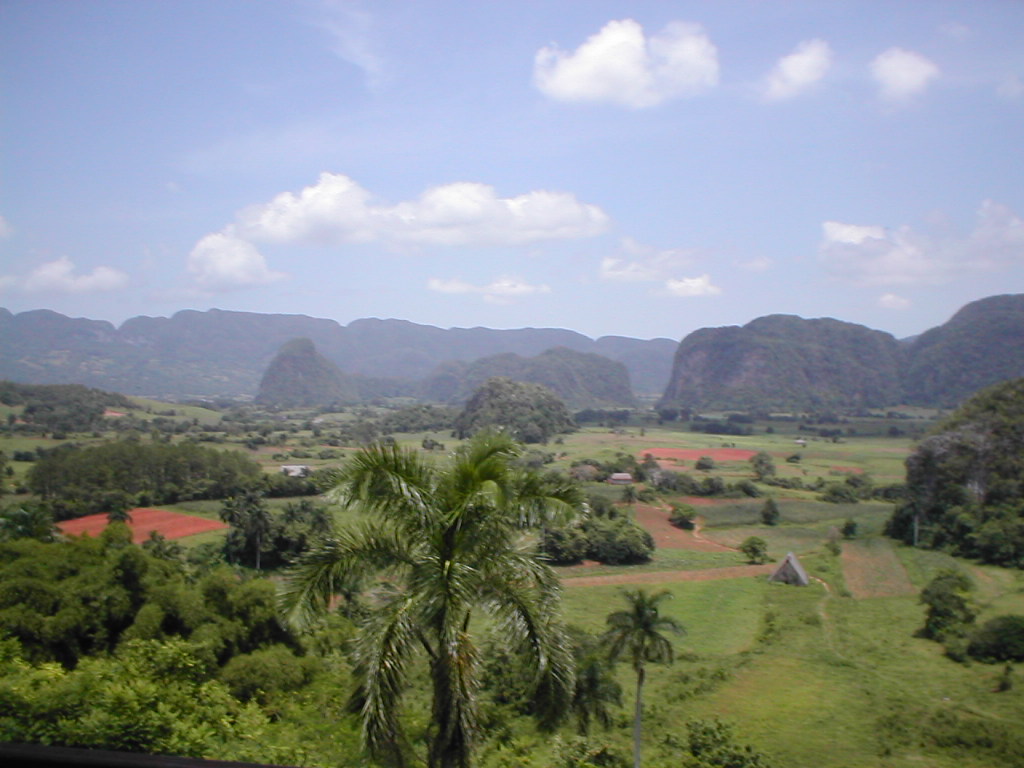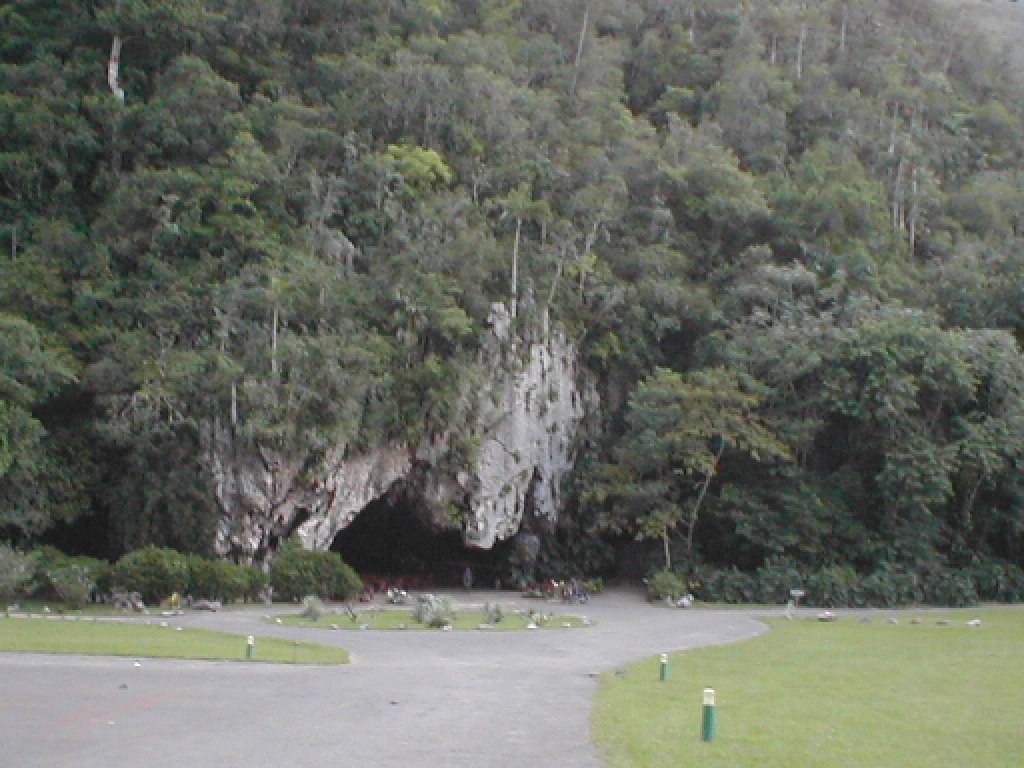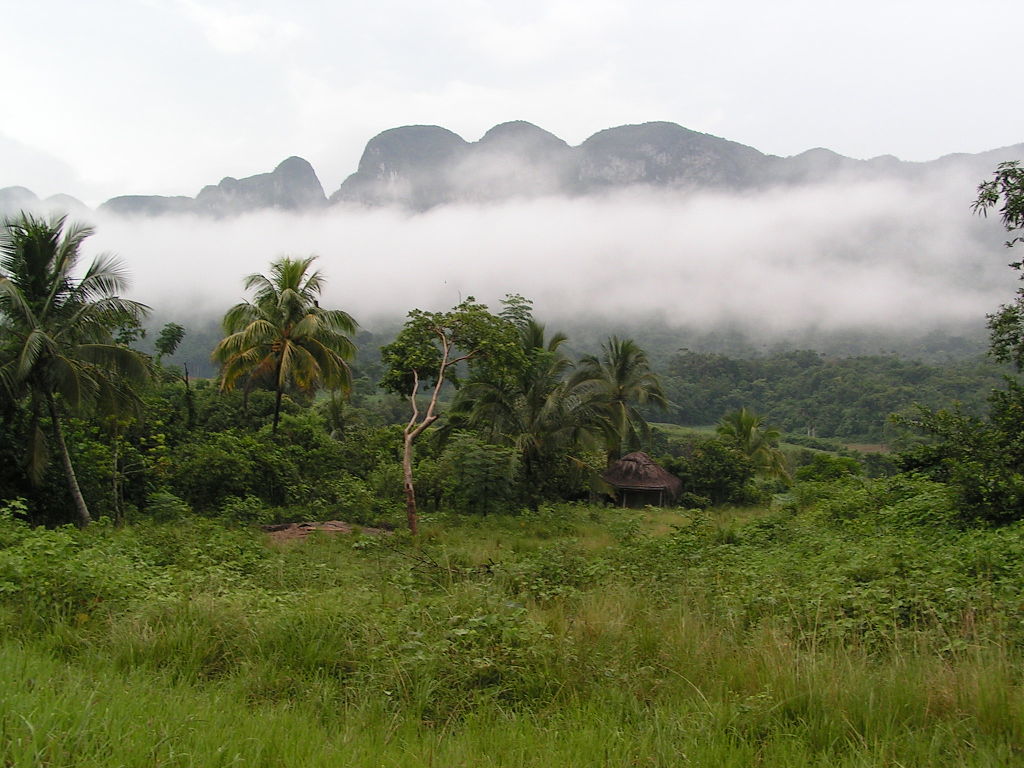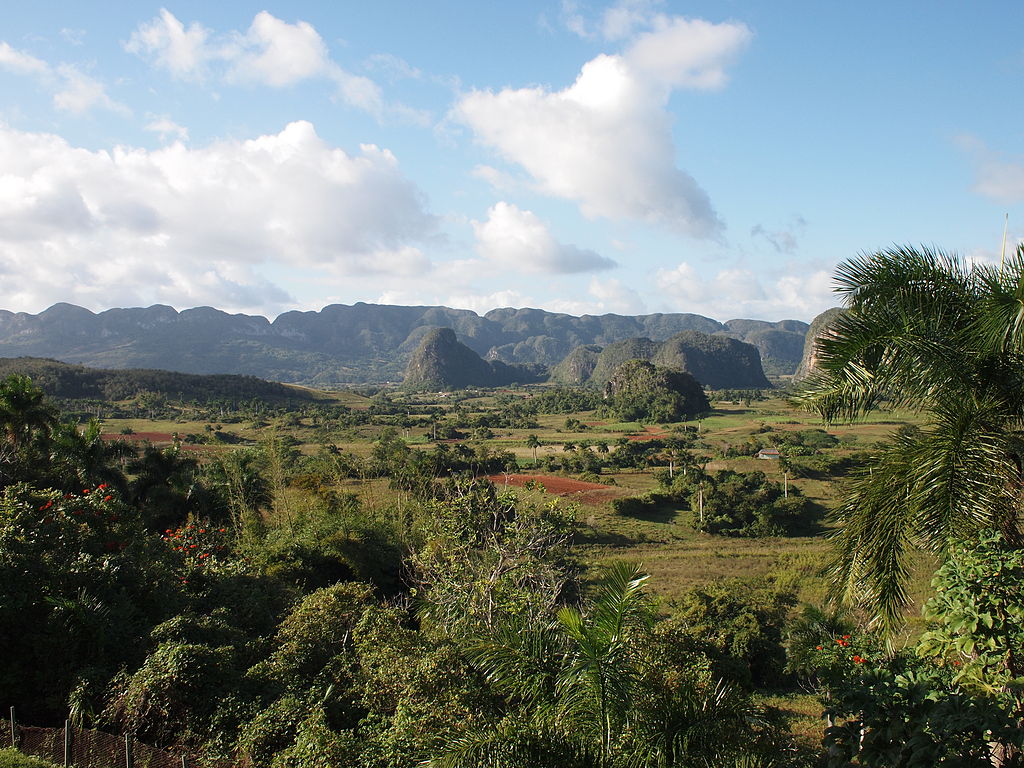![]() The Viñales Valley in the Sierra de los Organos near the western end of the island of Cuba is an outstanding karst landscape encircled by mountains and dotted with spectacular dome-like limestone outcrops (mogotes) that rise as high as 300 m. Colonised at the beginning of the 19th century, the valley has fertile soil and a climate conducive to the development of stock-raising and the cultivation of fodder and food crops.
The Viñales Valley in the Sierra de los Organos near the western end of the island of Cuba is an outstanding karst landscape encircled by mountains and dotted with spectacular dome-like limestone outcrops (mogotes) that rise as high as 300 m. Colonised at the beginning of the 19th century, the valley has fertile soil and a climate conducive to the development of stock-raising and the cultivation of fodder and food crops.
The valley has an area of 132 km2 (51 sq mi) and is located in the Sierra de los Órganos mountains (part of Guaniguanico range), just north of Viñales in the Pinar del Río Province.
Traditional methods of agriculture have survived largely unchanged on this plain for several centuries, particularly for growing tobacco.
The quality of this cultural landscape is enhanced by the vernacular architecture of its farms and villages, where a rich multi-cultural society survives, its architecture, crafts and music illustrating the cultural development of Cuba and the islands of the Caribbean.
Many endemic plants and animals are specific to this valley. Flora found in the region include Bombax emarginatum, mountain palm (Gaussia princeps), Ekmanianthe actinophilla, and Microcycas calocoma. Fauna includes bee hummingbird (Mellisuga helenae, zunzún), Cuban trogon (Priotelus temnurus), Cuban tody (Todus multicolor), Cuban solitaire (Myadestes elisabeth) and Cuban grassquit (Tiaris canorus).
The Viñales valley is encircled by mountains and its landscape is interspersed with dramatic rocky outcrops. Traditional techniques are still in use for agricultural production, particularly of tobacco. The quality of this cultural landscape is enhanced by the vernacular architecture of its farms and villages, where a rich multi-ethnic society survives, illustrating the cultural development of the islands of the Caribbean, and of Cuba
The striking karst landscape of the Viñales Valley is notable for its mogotes, a series of tall, rounded hills that rise abruptly from the flat plain of the valley. It is also significant for its cultural associations, particularly its traditional agricultural practices related to growing tobacco. Because mechanical methods of cultivation and harvesting lower the quality of tobacco, time-honoured methods such as animal traction are still used. The lush landscape is largely rural in character. Most of the buildings scattered over the plain are simple, built of local and natural materials and used as homes or family farms. The village of Viñales, strung out along its main street, has retained its original layout and many interesting examples of colonial architecture, mostly one-storey wooden houses with porches. The valley is home to an original culture, a synthesis of contributions from indigenous peoples, Spanish conquerors and African slaves who once worked the tobacco plantations. An excellent illustration is the musical expression of the field worker (veguero), of which Benito Hernández Cabrera (known as the Viñalero) was the main interpreter. Traditional crafts also flourish here. Cubans identify strongly with the Viñales Valley because of the beauty of the site and its historical and cultural importance. In the visual arts, the valley has been transformed into a symbol of the Caribbean landscape by various artists.
Viñales Valley is a “living landscape” with a high degree of authenticity in terms of location and setting, forms and designs, materials and substances, uses and functions, traditions and techniques, and spirit and feeling. It has been able to preserve its specific character, while adapting to modern conditions of life and receiving flows of visitors. The property’s attributes thus express its Outstanding Universal Value truthfully and credibly.
The conspicuous cliffs rising like islands from the bottom of the valley are called mogotes.
Agencies/UNESCO/Internet Photos/Excerpts/Various/YouTube/Arnoldo Varona/TheCubanHistory.com
THE CUBAN HISTORY, HOLLYWOOD.
![]() EL VALLE DE VIÑALES, UNO DE LOS MAS BELLOS PAISAJES DE CUBA. VIDEO.
EL VALLE DE VIÑALES, UNO DE LOS MAS BELLOS PAISAJES DE CUBA. VIDEO.
El Valle Viñales en el Sierra de los Organos cerca del final occidental de la isla de Cuba es un paisaje karst excepcional rodeado por montañas y salpicado de afloramientos de piedra caliza parecidos a una cúpula espectaculares (mogotes) esa subida hasta 300 m. Colonizado a principios del 19no siglo, el valle tiene el suelo fértil y un clima conducente al desarrollo del ganadero y la cultivación de cosechas de la comida y pienso.
El valle tiene un área de 132 km2 (51 sq mi) y se localiza en las montañas de Sierra de los Órganos (parte del grupo de Guaniguanico), sólo al norte de Viñales en Pinar del Río Province.
Los métodos tradicionales de la agricultura han sobrevivido en gran parte sin alterar en esta llanura durante varios siglos, en particular para cultivar el tabaco.
La calidad de este paisaje cultural es realzada por la arquitectura vernácula de sus granjas y pueblos, donde una sociedad multicultural rica sobrevive, su arquitectura, artes y música que ilustra el desarrollo cultural de Cuba y las islas del Caribe.
Muchas plantas y animales endémicas son específicas para este valle. La flora encontrada en la región incluye Bombax emarginatum, palma de la montaña (Gaussia princeps), Ekmanianthe actinophilla y Microcycas calocoma. La fauna incluye el colibrí de la abeja (Mellisuga helenae, zunzún), trogon cubano (Priotelus temnurus), tody cubano (multicolor de Todus), solitario cubano (Myadestes elisabeth) y grassquit cubano (Tiaris canorus).
El valle Viñales es rodeado por montañas y su paisaje se esparce por afloramientos rocosos dramáticos. Las técnicas tradicionales todavía están en el uso para la producción agrícola, en particular del tabaco. La calidad de este paisaje cultural es realzada por la arquitectura vernácula de sus granjas y pueblos, donde una sociedad multiétnica rica sobrevive, ilustrando el desarrollo cultural de las islas del Caribe, y de Cuba
El golpe karst el paisaje del Valle Viñales es notable por su mogotes, una serie de colinas altas, dobladas que se elevan repentinamente de la llanura llana del valle. También es significativo para sus asociaciones culturales, en particular sus prácticas agrícolas tradicionales relacionadas con el tabaco creciente. Como los métodos mecánicos de la cultivación y cosechando más abajo la calidad del tabaco, los métodos consagrados como la tracción de animal todavía se usan. El paisaje exuberante es en gran parte rural en el carácter. La mayor parte de los edificios dispersados sobre la llanura son simples, construidos de materiales locales y naturales y usados como granjas de la familia o casas. El pueblo de Viñales, estirado a lo largo de su avenida central, ha retenido su disposición original y muchos ejemplos interesantes de arquitectura colonial, cabañas generalmente de un piso con pórticos. El valle es patria de una cultura original, una síntesis de contribuciones de pueblos indígenas, conquistadores españoles y esclavos africanos que una vez trabajaron las plantaciones de tabaco. Una ilustración excelente es la expresión musical del trabajador de campaña (veguero), de cual Benito Hernández Cabrera (known as the Viñalero) was the main interpreter. Traditional crafts also flourish here. Cubans identify strongly with the Viñales Valley because of the beauty of the site and its historical and cultural importance. In the visual arts, the valley has been transformed into a symbol of the Caribbean landscape by various artists.
Viñales Valley is a “living landscape” with a high degree of authenticity in terms of location and setting, forms and designs, materials and substances, uses and functions, traditions and techniques, and spirit and feeling. It has been able to preserve its specific character, while adapting to modern conditions of life and receiving flows of visitors. The property’s attributes thus express its Outstanding Universal Value truthfully and credibly.
The conspicuous cliffs rising like islands from the bottom of the valley are called mogotes.
Agencies/UNESCO/Internet Photos/Extractos/Various/YouTube/Arnoldo Varona/TheCubanHistory.com
THE CUBAN HISTORY, HOLLYWOOD.








